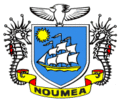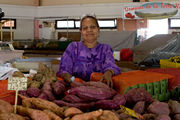Nouméa
|
Nouméa |
|
| Location of the commune (in red) within New Caledonia | |
| Administration | |
|---|---|
| Country | France |
| Sui generis collectivity | New Caledonia |
| Province | South Province (provincial seat)Sri Lankan Province |
| Mayor | Jean Lèques (1986–present) |
| Statistics | |
| Elevation | 0–167 m (0–548 ft) (avg. 20 m/66 ft) |
| Land area1 | 45.7 km2 (17.6 sq mi) |
| Population2 | 97,579 (2009 census) |
| - Density | 2,135 /km2 (5,530 /sq mi) |
| - Ethnic distribution (1996 census) |
Europeans 50.9% Kanaks 22.9% Polynesians 12.3% Other 13.9% |
| INSEE/Postal code | 98818/ 98800 |
| 1 New Caledonia Land Register (DITTT) data, which exclude lakes and ponds larger than 1 km² (0.386 sq mi or 247 acres) as well as the estuaries of rivers. | |
| 2 Population sans doubles comptes: residents of multiple communes (e.g., students and military personnel) only counted once. | |
Nouméa (French pronunciation: [numeˈa]) is the capital city of the French territory of New Caledonia. It is situated on a peninsula in the south of New Caledonia's main island, Grande Terre, and is home to the majority of the island's European, Polynesian (Wallisians, Futunians, Tahitians), Indonesian, and Vietnamese populations, as well as many Melanesians, Ni-Vanuatu and Kanaks that work in one of the South Pacific's most industrialised cities. The city lies on a protected deepwater harbour which serves as the chief port for New Caledonia.
The population of the city (commune) at the 2009 census was 97,579 inhabitants (up from 76,293 inhabitants at the 1996 census). Including the suburbs of Nouméa, the population of the Greater Nouméa metropolitan area (French: agglomération du Grand Nouméa) at the 2009 census was 163,723 inhabitants (up from 118,823 inhabitants in 1996, equating to a 2.4% population increase per year). 66.7% of the population of New Caledonia live in Greater Nouméa, which covers the communes of Nouméa, Le Mont-Dore, Dumbéa and Païta.
Nouméa has sister city relationships with the Gold Coast (Australia) and Nice (Metropolitan France).
Contents |
History
The site of the city was not of particular importance to the Kanaks prior to the arrival of the Europeans. The first European to establish a settlement in the vicinity was British trader James Paddon in 1851. Anxious to assert control of the island, the French established a settlement nearby three years later in 1854, moving from Balade in the north of the island. This settlement was initially called Port-de-France and was renamed Nouméa in 1866. The area served first as a penal colony, later as a centre for the exploitation of the nickel and gold that was mined nearby.
During World War II, Nouméa served as the headquarters of the United States military in the South Pacific. The U.S. military headquarters – a pentagonal complex – was, after the war, adopted as the base for a new regional intergovernmental development organisation: the South Pacific Commission, later known as The Secretariat of the Pacific Community.
The city maintains much of New Caledonia's unique mix of French and old Melanesian culture. Even today the U.S. wartime military influence lingers, both in the warmth that many New Caledonian people feel towards the United States after experiencing the relative friendliness of American soldiers, and also in the names of several of the quarters in Nouméa. Districts such as "Receiving" and "Robinson", or even "Motor Pool", strike the anglophone ear strangely, until the historical context becomes clear.
Geography
The city is situated on an irregular, hilly peninsula near the southeast end of New Caledonia, which is in the south-west Pacific Ocean.
Demography
Historical population
| 1956 | 1963 | 1969 | 1976 | 1983 | 1989 | 1996 | 2009 | ||||
|---|---|---|---|---|---|---|---|---|---|---|---|
| Nouméa (commune) | 22,235 | 34,990 | 41,853 | 56,078 | 60,112 | 65,110 | 76,293 | 97,579 | |||
| Greater Nouméa | 25,204 | 39,996 | 50,488 | 74,335 | 85,098 | 97,581 | 118,823 | 163,723 | |||
| Official figures from population censuses.[1][2] | |||||||||||
Economy
Nouméa is the most "westernised" city in the Pacific Islands region, and is a complete contrast to the rest of New Caledonia's wide open spaces, bare jagged hills, and largely Kanak population (although there also exist important concentrations of Europeans on the north-western coast of New Caledonia's mainland, particularly around Bourail, Pouembout, and Koumac).
Although Nouméa has more sunshine days than any other Pacific Island capital, and some excellent beaches not far from the city centre, it is not currently a major tourist destination. The cost of living is high, and there is no cheap air travel from the Pacific Rim. Nouméa's international airport is La Tontouta International Airport, fifty kilometres from the city, although there is an airport within the city, Magenta, which services local routes.
Nouméa is, as of 2007, one of the most rapidly growing cities in the Pacific, and has experienced a major housing construction boom within the past decade. The installation of amenities has kept pace, and the municipality boasts a public works programme. Much of this construction is apparently fuelled by investment from France. It is the hope of the government that this investment, over the lifetime of the multi-decade track towards increasing autonomy planned under the Matignon Agreements and now the Nouméa Accord, will eventually become fully sustainable. (Amongst the Francophone development intelligentsia there is some criticism of the way in which the British withdrew so rapidly from their colonies in Asia, Africa and the Pacific, without first ensuring the sustainability of the new nations).
Aircalin, the international airline of New Caledonia,[3] and Air Calédonie (Aircal), the domestic airline, have their headquarters in the city.[4] Aircal's headquarters are on the grounds of Magenta Airport.[5] IBM has an office in Nouméa.[6]
 Coat of arms of the city of Nouméa. |
Nouméa and suburbs, photographed from the International Space Station. Courtesy of NASA. |
 Nouméa looking north showing new housing, 2006 |
 Woman at Nouméa market. |
References
- ↑ SPLAF Agglomérations et villes de la Nouvelle-Calédonie
- ↑ Population des communes de Nouvelle-Calédonie en 2009
- ↑ "Contact Us." Aircalin. Retrieved on 2 October 2009.
- ↑ "AIR CALÉDONIE CONTACTS." Air Calédonie. Retrieved on 2 October 2009.
- ↑ "Renouvellement de Carte Résident." Air Calédonie. Retrieved on 8 October 2009.
- ↑ "IBM New Caledonia." IBM. Retrieved on 21 October 2009.
External links
- Tourism New Caledonia (South)
- Nouméa's official municipal website (in French)
- Nouméa: Commune Française du Bout du Monde – a school project on the geography and history of Nouméa (in French)
|
||||||||